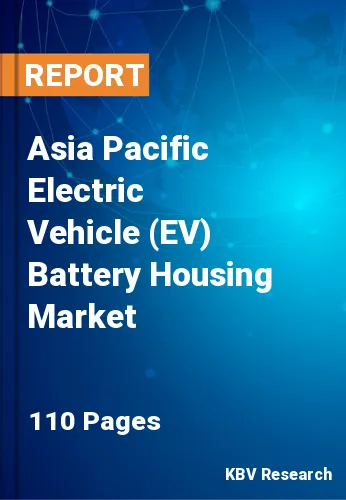The Asia Pacific Electric Vehicle (EV) Battery Housing Market would witness market growth of 13.5% CAGR during the forecast period (2023-2030).
The primary function of EV battery housing is to protect and contain the lithium-ion batteries within a secure and robust enclosure. This protection is essential to keep external elements like water, dust, and debris from affecting the battery pack's integrity and safety. Energy-efficient thermal management is critical for lithium-ion batteries to operate safely and effectively. EV battery housing incorporates advanced thermal management systems, including cooling and heating elements, to regulate the temperature within the battery pack. This helps prevent overheating during charging and discharging cycles, contributing to the longevity of the batteries and ensuring safe operation.
Ongoing innovations in materials and design aim to reduce the weight of electric vehicle battery housing. Lightweight materials, including advanced composites and high-strength alloys, are employed to reduce weight without compromising structural integrity. EV battery housing is not merely a functional component but also a design element that influences the exterior appearance of electric vehicles. Manufacturers are investing in innovative and visually appealing designs that contribute to the overall attractiveness of electric vehicles, helping to overcome traditional perceptions of electric cars as utilitarian.
Japan is home to some of the world's leading automotive manufacturers, including Toyota, Nissan, and Honda. Japan is known for its expertise in battery chemistry. The country has been at the forefront of developing lithium-ion battery technologies widely used in electric vehicles. Japan places a significant emphasis on energy storage solutions, not only for electric vehicles but also for broader applications. The interest in grid storage and other energy-related technologies contributes to advancements in battery technology in Japan, with implications for EV battery housing design and functionality. Thus, due to these aspects, the market will expand across the Asia Pacific region in upcoming years.
The China market dominated the Asia Pacific Electric Vehicle (EV) Battery Housing Market by Country in 2022, and would continue to be a dominant market till 2030; thereby, achieving a market value of $3,417.4 Million by 2030. The Japan market is registering a CAGR of 12.7% during (2023 - 2030). Additionally, The India market would showcase a CAGR of 14.3% during (2023 - 2030).
Free Valuable Insights: The Global Electric Vehicle (EV) Battery Housing Market is Predict to reach $24.3 Billion by 2030, at a CAGR of 13.2%
Based on Vehicle Type, the market is segmented into Passenger Car and Commercial Car. Based on Material, the market is segmented into Aluminium, Steel and Others (Carbon Fibre & Carbon Glass). Based on countries, the market is segmented into China, Japan, India, South Korea, Singapore, Malaysia, and Rest of Asia Pacific.
By Vehicle Type
By Material
By Country
Our team of dedicated experts can provide you with attractive expansion opportunities for your business.

